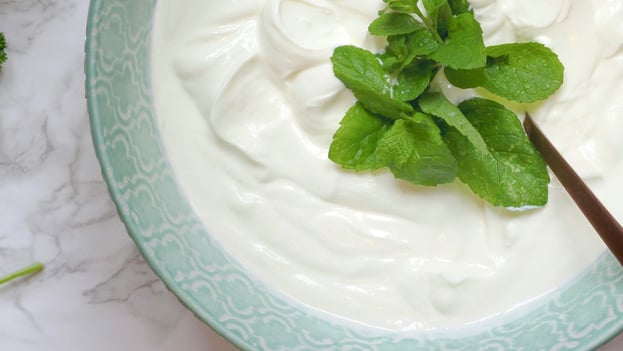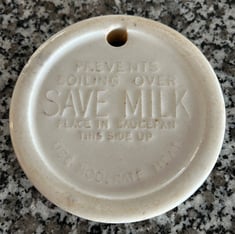Make Yoghurt at Home
Discover easy instructions and facts for making delicious yoghurt. Follow our simple yoghurt recipe to enjoy fresh, creamy yoghurt Perfect for beginners! so easy to make yoghurt at home.


The Origins of Yoghurt
Yoghurt has nourished civilizations since 5000 BCE. The word is Turkish in origin and derives from the root word "you", meaning to thicken or condense. Fresh milk might spoil in a few hours in hot climates, so it is given a longer shelf life by inoculating with "good" bacteria. The bacteria acidifies the milk by producing lactic acid, making life difficult for pathogens that cause spoilage. When strained and salted, the yoghurt can be kept a few days longer without refrigeration. Over the last 100 years yoghurt has transitioned from a regional ethnic food made at home to a food made by corporations in enormous quantities, using stabilisers preservatives, thickening agents, sweeteners and flavourings.
Starting the fermentation
A traditional starter culture is made of micro-organisms that are added to the milk to initiate fermentation, turning the milk into yoghurt. Streptococcus thermophiles (ST) and Lactobacillus delbrueckii subspecies bulgaricus (LB) are the most common starter cultures, and other bacteria often added to yoghurt as extra probiotics. At the right temperature, ST bacteria is activated first, creating the initial rise in acidity, stimulating the growth of the LB bacteria. The growth of the LB thickens the milk. The two cultures stimulate each other and grow faster together, driving down the pH, inhibiting the growth of undesirable mould and bacteria that causes spoilage.
About Lactose
Lactose is the main sugar found in milk. Some people don't have enough of the enzyme called lactase, which is found in the gut of humans. Lactase is needed to breakdown lactose. Without lactase, the lactose can pass through the gut undigested and cause unpleasant symptoms. Many people who can't consume fresh milk without gastric upset find yoghurt more digestible. Yoghurt is not lactose-free, but it usually has much less lactose than milk. The bacteria has converted the lactose into lactic acid. The lactic acid is what creates the tart taste.
Strained yoghurt, or Greek yoghurt, has little lactose, because straining removes the whey. The lactose that didn't get digested by the bacteria is found in the whey. Many commercial yoghurts, especially low-fat varieties, have added milk powder to increase the protein level, improving the mouth feel that is affected by the removal of the fat. The addition of the added milk powder increases the lactose level. Even after fermentation, the lactose concentration can be quite high.
If you are sensitive to lactose, be mindful of portion sizes. More than one low-lactose food eaten together in one meal may add up to a larger amount than your system can tolerate.
Choosing the Milk
To make the best yoghurt always start with fresh milk.
You can make yoghurt with full-cream, low-fat, cow, goats, buffalo or sheep milk. Full-cream milk gives a richer, creamier and better mouth feel than low-fat milk. You can use homogenised or non-homogenised, the latter will make a yoghurt with a rich cream layer on the top. The cream can be mixed back into the yoghurt when ready to serve.
Some people use UHT (Ultra-high Treatment) milk to make yoghurt. Since it has been taken to such a high temperature it has lost some of its nutritional benefits. There is no need to heat the milk above 43°C, the whole carton can go into a water bath before inoculating with the bacteria culture. Lactose-free milk has the addition of the enzyme lactase, which splits the sugar molecule into glucose and galactose. The sugar is still present in the milk, just in a different form. The bacteria will still be able to turn the milk into yoghurt.
If you can tolerate the extra lactose, you can mix in some non-fat dry milk powder. The dry milk powder boosts the protein content, compensating for the lack of fat content, yielding a thicker yoghurt. The milk powder is added in the ratio of 2 tablespoons per litre of milk.
Goats milk has fewer solids than cows milk, so it makes a thin yoghurt. This is the reason a lot of goat milk yoghurts have added thickening agents.
Many commercial yoghurts rely on stabilizers such as corn starch or tapioca starch to create a firmer texture. Adding stabilizers also reduces "wheying off", the release of whey over time. The whey appears as a layer of yellowish liquid on the top of the yoghurt. This happens over time and is a natural property of yoghurt.
Why Heat the Milk First?
The milk we buy from the store is pasteurised. Pasteurisation kills pathogens (organisms that cause disease), but it doesn't sterilise the milk. Some bacteria can still be present and this bacteria competes with the yoghurt culture, spoiling the yoghurt. By heating the milk to 85°C, you eliminate the competitors, leaving all the food for the desired yoghurt-making bacteria. Heating the milk also breaks apart the bonds between the milk proteins, making them more easily digested by the bacteria, resulting in better coagulation, producing a creamier yoghurt, rather than grainy clumping curds. When heating the milk, it should be stirred to prevent burning on the bottom of the pan.


Heat the milk to 90°C and keep it at that temperature for 10 minutes. This long heating makes a smooth yoghurt, a short heating time results in a grainy textured yoghurt.
Choosing a Starter
A starter culture is needed to get the fermentation going. If you have invested in a dried yoghurt culture, follow the manufacturers instructions regarding the amount of culture used. Keep the culture in an air-tight container (heat and moisture are the enemy of the culture) in the freezer where it will remain viable for several years.
There are many cultures to choose from when making your own yoghurt, some examples are Bulgarian, Greek, Caspian Sea, Skyr and Filmjolk.
Using more culture than recommended will not produce a thicker yoghurt, the opposite is true. The milk won't contain enough sugars to feed the amount of bacteria and the competition for food will render the bacteria unable to thicken the milk, resulting in a thin yoghurt.
If you are fortunate enough to own an old-fashioned ceramic milk saver, now is the time to use it. They can sometimes be found in antique shops. A milk saver sits in the bottom of the pan and the milk is poured on top, then heated. It prevents the milk from boiling over. The bubbles travel through the hole in the saver stopping the milk from boiling over if to gets too hot. It makes a rattling sound as the bubbles push it about, letting you know the milk is overheating, before the milk burns at the bottom.
Choosing an incubation method
Thermophilic Yoghurt bacteria, such as Bulgarian, Greek and Icelandic Skyr, are heat-loving cultures that are activated by warmer levels of heat, they need to be incubated in a temperature range of 39 to 46°C
Above 46°C the bacteria will be killed, below 39°C the culture will produce more polysaccharides, causing a slimy, thin or ‘ropy’ texture or may not set at all.
42°C is the ideal incubating temperature for Thermophilic yoghurt culture, to make a sweet tasting thick yoghurt.
Yoghurt needs to be kept warm for several hours to give the culture time to do its job.
If you don’t have an electric yoghurt maker, you can incubate it the way that cooks have done for centuries, wrapped up in a blanket and placed in a warm spot in the house, near a heater or next to a sunny window.
Some people use a picnic cooler partly filled with warm water, topping up with hot water if the temperature cools off.
A slow cooker or a dehydrator with a low heat setting can be used. Some ovens have a pilot light or a proofing setting that can be the right temperature.
Use a thermometer to check the temperature.
A little experimenting is all it takes to find out what works for you.
How long does it take to turn into yoghurt?
It takes 4 to 12 hours to set the yoghurt, depending on your method of incubation and the strength of the culture. The longer the fermenting time, the less sugar remains, making a more tart yoghurt. It's in your control.
Start to check on your yoghurt after 5 hours, If it's kept at the ideal temperature, 42°C it could be nicely set. If it isn't set it will need more time, or a little more warmth.
If you like it more tart leave for an hour or 2 longer to give the bacteria time to consume more of the sugars, giving that tart taste.
Whichever method you use, avoid moving the yoghurt to much it prefers to be undisturbed.
Taradale, Victoria. Australia 3447
